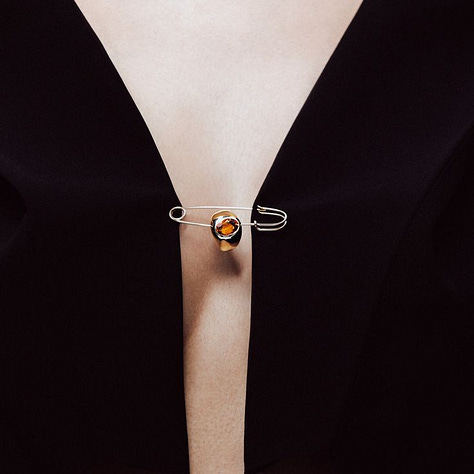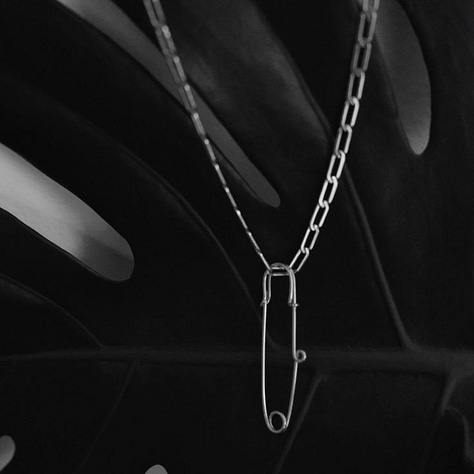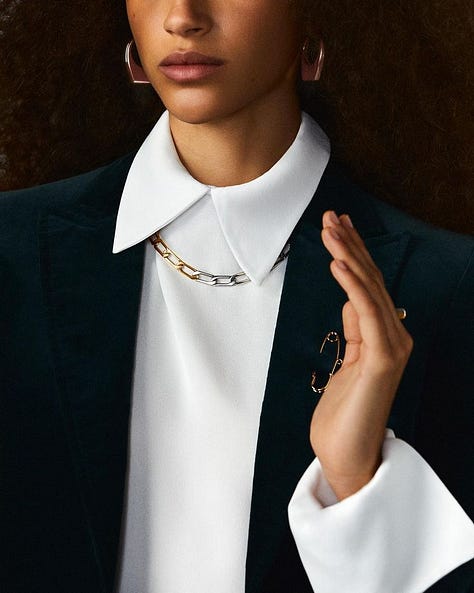Brooches hold the power of transition
They capture the tension between anchoring a memory and the nature of change.

Some context
Brooches are SO HOT and relevant now, from so many vantage points. Their resurgence is cultural, political, and personal.
In an overview, brooches are the outermost layer of our presentation as individuals.
They demand decision in ways other adornments don't. Rings slide onto fingers, earrings hook through lobes—all settling onto the body almost instinctively. But brooches forces a conscious relationship with fabric, movement, and the observer’s gaze. This deliberation constitutes its fundamental power.
While we're constantly pushed toward defining ourselves in absolute terms, I find profound freedom in these small objects that migrate across our wardrobes, reinventing themselves with each new placement; Refreshingly transient.
This article has been in the making for a minute. The draft emerges in a moment when the world feels especially unyielding, a time that calls for clarity, conviction, and courage. Jewelry is communication, and the brooch is perhaps the pinnacle. A note on my phone started it:
Brooches hold the power of transition. With each shift across the body, they capture the tension between anchoring a memory and the nature of change.
What draws me most to brooches is their eloquence. In their stubborn materiality, they remind us of the importance of tactile experience and embodied communication.
Recent runway shows were flooded with them, positioned as counterpoints to austere silhouettes and palettes. Fashion-wise, they expand our visual vocabulary.
"The typical accessories of femininity: the bra, the brooches, the fur,”[…]“The question is, what do we retain of femininity? Does it help in this really dangerous moment? In wartime?” Miuccia Prada told Sarah Mower for Vogue Runway. A sharp narrative focus in Miu Miu’s 2025 Ready-to-Wear collection—I LOVED the view of
on it:The world often feels too virtual and disembodied, bringing opinions to the physical body feels like a radical act. I personally believe that wearing convictions requires more commitment than posting them. Brooches have long been linked to politics precisely because they transform beliefs into material presence.
Take the anti-slavery medallions produced by Josiah Wedgwood in the late 18th century, often worn as brooches–small ceramic discs depicting a kneeling enslaved person with the phrase "Am I Not a Man and a Brother?". Similarly, suffrage pins worn by women fighting for the vote were visual arguments for equality, and were worn publicly on bodies that were themselves political battlegrounds.
When Josephine Baker’s brooches appeared in the 1935 film "Princess Tam Tam" they were loaded symbols, speaking to the intersections of race, gender, and nationality.
I don't even need to bring specific examples of military pins, you can picture them.
The brooch's queer history deserves special attention. From the green carnation boutonnières associated with Oscar Wilde to the geometric pins that served as subtle recognition signals in mid-century lesbian communities, brooches have long functioned as coded communications in LGBTQ+ contexts.
André Leon Talley's magnificent brooches were a masterclass in the theatrical potential of them.
Fashion, politics, and culture are inseparable. Look at the Oscars, a hyper-controlled event, brooches are a way of creating a narrative. Brooches also hold a unique, multi-gender appeal. They offer a newcomer a chance to wear a diamond or a bolder gemstone and make a statement. It’s also a precise, almost surgical way to express an opinion.
I've heard before that brooches look dated. There's an underlying suggestion that wearing our opinions in such an overt way has fallen out of style. It's not that brooches themselves are outdated, but maybe we got lazy.
No wonder they are trending now.
Good to know
The terminology—fibula, boutonnière, pin, brooch—carries distinct connotations and are important keywords for shopping:
A fibula, derived from Latin, originally functioned as a safety pin in ancient civilizations across Northern Africa and Europe. It holds the garment together.
The boutonnière, meaning "buttonhole" in French, evolved from the practice of threading flowers through jacket buttonholes, eventually becoming more permanent floral-inspired metal adornments.
Pins, simpler and often smaller, serve as minimal statements.
Brooch—from the French "broche" meaning "long needle"—encompasses the more ornate, statement-making pieces we associate with the form today.
Goodies
For fine jewelry with a minimalist appeal, Prasi is the best with the Saudade safety pin.



At a recent
event in New York, Marc Bridge wore a sweet Monbouquette piece with a little leaf in it.
This Agmes brooch in the wedding bouquet, how cute.
Adrien Brody's statement brooches by Elsa Jin.
The substack community has embraced brooch discourse with particular enthusiasm. I've shared a few in Notes, but I especially love the oversized Carolina Herrera piece and Simone Rocha's sock-styling approach:
As brooches are barely touching the skin, it's easy to escape the material limits of other jewelry types. This freedom invites bold experiments in weight, scale, and unconventional materials, making them a canvas for artistic innovation. I'd suggest taking a look at Caro Editions and this one from Dior.
Sara's from DAER DISCOVERS wrote Are Brooches back? and an absolute chef’s kiss to the selection–I'm crazy about this one from Albert Coll.
I’m grateful you took the time to read, wishing you a great week!
Sending love,
Ísis







If brooches signal a transition, do they mark the shift or do they soften it?
Thanks so much for the mention!